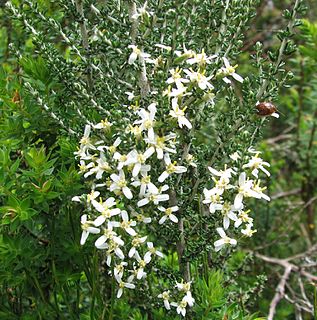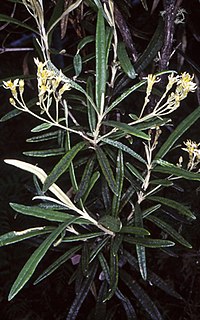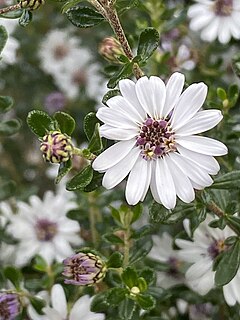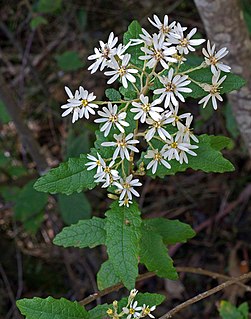
Olearia, most commonly known as daisy-bush, is a genus of flowering plants belonging to the family Asteraceae, the largest of the flowering plant families in the world. Olearia are found in Australia, New Guinea and New Zealand. The genus includes herbaceous plants, shrubs and small trees. The latter are unusual among the Asteraceae and are called tree daisies in New Zealand. All bear the familiar daisy-like composite flowerheads in white, pink, mauve or purple.

Olearia phlogopappa commonly known as the dusty daisy-bush or alpine daisy-bush is a species of flowering plant in the family Asteraceae that is commonly found in eastern New South Wales, Victoria and Tasmania. It is a small shrub with greyish-green foliage, daisy-like flowers in white, pink or mauve that can be seen from spring to late summer.

Lasiopetalum behrii, commonly known as the pink velvet bush, is a species of flowering plant in the family Malvaceae and is endemic to southern continental Australia. It is an erect shrub with lance-shaped, narrowly oblong to narrowly elliptic leaves and groups of white to pink and reddish-brown flowers.

Olearia algida, the alpine daisy-bush is a species of flowering plant in the family Asteraceae and is endemic to south-eastern Australia. It is a shrub with small, crowded, elliptic to narrow egg-shaped leaves with the narrower end towards the base and heads of white and cream-coloured, daisy-like flowers.

Olearia megalophylla, the large-leaf daisy bush, is a species of flowering plant in the family Asteraceae. It is a shrub up to 2 metres high with scattered leaves. These are dark green above, woolly underneath, and are 20 to 120 mm long and 6 to 28 mm wide. The flower heads have 5 to 9 white ray florets and 9 to 14 yellow disc florets. The species was first formally described by Ferdinand von Mueller in Papers and Proceedings of the Royal Society of Tasmania in 1859 and named Eurybia megalophylla. In 1865, he placed the species in the genus Aster and finally in Olearia in 1867. It occurs in moist sclerophyll forest in south-eastern New South Wales and Victoria.

Olearia erubescens, commonly known as moth daisy-bush or pink-tip daisy-bush, is a species of flowering plant in the family Asteraceae. It is a shrub with stiff, prickly leaves and white "daisy" flowers, growing up to 2 metres high.

Olearia floribunda, commonly known as heath daisy-bush, is a species of flowering plant in the family Asteraceae.

Olearia elliptica, commonly known as the sticky daisy bush, is a shrub in the daisy family, Asteraceae and is native to New South Wales and Queensland in eastern Australia. It has scattered, sticky leaves and white flowers in summer and autumn.

Olearia asterotricha, commonly known as rough daisy-bush, is a species of flowering plant in the family Asteraceae. A tall shrub with white, mauve or blue daisy like flowers growing from the Blue Mountains in New South Wales to western Victoria, Australia.

Arckaringa Station is a pastoral lease in the Australian state of South Australia which that once operated as a sheep station but now operates as a cattle station.

Felicia nordenstamii is a flowering shrub in the daisy family, Asteraceae. It is found only in South Africa where it grows on limestone hills close to the sea on the southern coast. Felicia nordenstamii is a many-branched shrub growing up to 30 cm (1 ft) tall. The lower parts of the stems are covered in grayish brown bark and the upper stem has many crowded, upwardly angled, alternate leaves with long hairs on the lower surfaces. Large flower heads form at the tips of the branches, each about 41⁄2 cm across, with about thirty purplish blue ray florets surrounding many yellow disc florets.
Olearia adenolasia, commonly known as woolly-glandular daisy-bush, is a species of flowering plant in the family Asteraceae. It is a small upright shrub with sticky leaves and blue-purple or white daisy flowers.
Olearia aglossa, is a shrub in the family Asteraceae and is found in mountainous terrain in New South Wales and Victoria in Australia. It is a small shrub with spreading upright branches and white daisy-like flowers.

Olearia alpicola, commonly known as alpine daisy bush, is a shrub in the family Asteraceae and is found in mountainous terrain in New South Wales and Victoria in Australia. A small shrub with spreading branches and white daisy-like inflorescences.

Olearia magniflora, commonly known as the splendid daisy-bush, is a small shrub with clusters of deep mauve to purple flowers.

Olearia ciliata, commonly known as the fringed daisy bush, is a small shrub with large clusters of bright purple-blue flowers on a single stem.

Olearia minor, is a small flowering shrub in the family Asteraceae. It has alternate leaves and white to pale mauve daisy-like flowers from winter to December. It grows in Western Australia, South Australia, New South Wales, and Victoria.

Olearia oppositifolia is a species of flowering plant in the family Asteraceae and is endemic to eastern Australia. It is a shrub with egg-shaped to elliptic leaves arranged in opposite pairs, and white and yellow daisy flowers.

Olearia rugosa, commonly known as wrinkled daisy-bush, is a species of flowering plant in the family Asteraceae. It has alternate, wrinkled leaves and white daisy-like flowers and is endemic to Victoria.

Olearia archeri is a species of flowering plant in the family Asteraceae and is endemic to Tasmania. It is a shrub with small, crowded, narrowly elliptic leaves and white and yellow, daisy-like inflorescences.


















